Impacts of NO2 on Urban Air Quality and Causes of Its High Ambient Levels: Insights from a Relatively Long-Term Data Analysis in a Typical Petrochemical City in the Bohai Bay Region, China
Abstract
:1. Introduction
2. Materials and Methods
2.1. Study Area and Data Sources
2.2. Related Definitions
2.3. Analytical Methods
2.3.1. Methods for Analyzing Impact of NO2 on Air Quality
2.3.2. Methods for Analyzing the Causes of High NO2 Values
3. Results and Discussion
3.1. NO2 Concentration Levels and Variation Characteristics
3.1.1. Concentration Levels
3.1.2. Temporal Variation Characteristics
3.1.3. Spatial Variation Characteristics
3.2. Impact of NO2 on Air Quality
3.2.1. Impact of NO2 on Air Quality Levels
3.2.2. Impact of High NO2 Values on O3, PM2.5, and Atmospheric Oxidation Capacity in 2022
3.3. Causes of High NO2 Values
3.3.1. Meteorological Conditions
3.3.2. Chemical Generation
3.3.3. Sources Analysis
4. Conclusions
- (1)
- From 2017 to 2023, the annual assessment values of NO2 concentrations in Dongying exhibited a trend of initially decreasing and then stabilizing, with monthly variation characterized by a “U” distribution, diurnal variation characterized by a “single-peak, single-valley” distribution, and spatial variation characterized by a “high in the south-central part and low in the north” distribution. Higher daily NO2 concentrations mainly occurred during January-April and September-December each year, and higher hourly NO2 concentrations mainly occurred during the nighttime and morning rush hours.
- (2)
- NO2 is a contributing factor to the increase in various pollutant concentrations, thereby affecting air quality levels. High hourly NO2 values (NO2-HH) events promoted the increase in the concentrations of PM2.5 and PM2.5-bounded NO3-, SO42- and SOC, and OX during the nighttime and morning rush hours, and they also facilitated the increase in the concentrations of O3, PM2.5 and PM2.5-bounded NO3-, SO42- and SOC, and OX, as well as NOR and SOR values during the daytime. High daily NO2 values (NO2-HD) could promote the increase in the concentrations of O3 (MDA8-O3), PM2.5 and PM2.5-bounded NO3-, SO42- and SOC, and OX on the same day.
- (3)
- The occurrence of high NO2 values was affected by the combination of unfavorable meteorological conditions, local emissions and regional air pollution transports, and localized atmospheric chemical generation. High-pressure and uniform-pressure weather patterns, along with low temperatures (−5~15 °C), moderate humidity (30~80%), wind speeds below 1 m/s, and southwesterly winds, are conducive to high daily NO2 values. In 2022, land–sea breeze circulation significantly contributed to high NO2 concentrations. Random forest analysis indicates that in 2022, BLH in spring (−0.43) and winter (−0.36), WD in summer (0.21), and T (−0.46) in autumn were the primary factors contributing to NO2-HH, while BLH (−0.47) is the main cause for NO2-HD. The titration reaction between NO with O3 is the main cause for NO2-HH in spring, summer and fall, and photochemical reactions of Aromatics have a significant influence on NO2-HD. NOx emissions from the thermal power and petrochemical industry in Dongying and air pollution transports from western and southwestern Shandong Province (throughout the year) and from the Bohai Sea (during spring and summer) had serious adverse impact on high NO2 values.
Supplementary Materials
Author Contributions
Funding
Institutional Review Board Statement
Informed Consent Statement
Data Availability Statement
Conflicts of Interest
References
- Tang, X.Y.; Zhang, Y.H.; Shao, M. Atmospheric Environmental Chemistry; Higher Education Press: Beijing, China, 2024. [Google Scholar]
- Xia, N.; Du, E.Z.; Guo, Z.D.; Vries, W.D. The diurnal cycle of summer tropospheric ozone concentrations across Chinese cities: Spatial patterns and main drivers. Environ. Pollut. 2021, 286, 117547. [Google Scholar] [CrossRef] [PubMed]
- Yan, Y.H.; Wang, S.S.; Zhu, J.; Guo, Y.L.; Tang, G.Q.; Liu, B.X.; AN, X.X.; Wang, Y.S.; Zhou, B. Vertically increased NO3 radical in the nocturnal boundary layer. Sci. Total Environ. 2021, 763, 142969. [Google Scholar] [CrossRef]
- Lai, H.K.; Hedley, A.J.; Thach, T.Q.; Wong, C.M. A method to derive the relationship between the annual and short-term air quality limits-Analysis using the WHO Air Quality Guidelines for health protection. Environ. Int. 2013, 59, 86–91. [Google Scholar] [CrossRef]
- Zong, Z.; Tian, C.; Li, J.; Syed, J.H.; Zhang, W.; Fang, Y.; Jiang, Y.; Nasir, J.; Mansha, M.; Rizvi, S.H.H.; et al. Isotopic Interpretation of Particulate Nitrate in the Metropolitan City of Karachi, Pakistan: Insight into the Oceanic Contribution to NOx. Environ. Sci. Technol. 2020, 54, 7787–7797. [Google Scholar] [CrossRef] [PubMed]
- Richter, A.; Burrows, J.P.; Nuss, H.; Granier, C.; Niemeier, U. Increase in tropospheric nitrogen dioxide over China observed from space. Nature 2005, 437, 129–132. [Google Scholar] [CrossRef]
- Zhu, Y.J.; Zhan, Y.; Wang, B.; Li, Z.; Qin, Y.Q.; Zhang, K.S. Spatiotemporally mapping of the relationship between NO2 pollution and urbanization for a megacity in Southwest China during 2005–2016. Chemosphere 2019, 220, 155–162. [Google Scholar] [CrossRef]
- Lalitaporn, P.; Kurata, G.; Matsuoka, Y.; Thongboonchoo, N.; Surapipith, V. Long-term analysis of NO2, CO, and AOD seasonal variability using satellite observations over Asia and intercomparison with emission inventories and model. Air Qual. Atmos. Health. 2013, 6, 655–672. [Google Scholar] [CrossRef]
- Guan, Q.D.; Zuo, X.Q.; Li, S.H. Analysis of Distribution Characteristics and Driving Factors of Nitrogen Dioxide Concentration in China. Geomat. Spat. Inf. Technol. 2021, 44, 85–89+97. [Google Scholar]
- Nishanth, T.; Praseed, K.M.; Kumar, M.K.S.; Valsaraj, K.T. Observational Study of Surface O3, NOx, CH4 and Total NMHCs at Kannur, India. Aerosol Air Qual. Res. 2014, 14, 1074–1088. [Google Scholar] [CrossRef]
- Gao, J.H.; Zhu, B.; Wang, Y.Z.; Kang, H.Q. Distribution and long-term variation of tropospheric NO2 over China during 2005 to 2013. China Environ. Sci. (Chin. Ed.). 2015, 35, 2307–2318. [Google Scholar]
- Yang, G.F.; Li, S.Y.; Li, W.L. Spatial and temporal distribution characteristics of nitrogen dioxide concentration in Chinese cities. Environ. Sci. Technol. 2019, 42, 200–206. [Google Scholar]
- Wang, Y.J.; Yaluk, E.A.; Chen, H.; Jiang, S.; Huang, L.; Zhu, A.S.; Xiao, S.L.; Xue, J.; Lu, G.B.; Bian, J.T.; et al. The Importance of NOx Control for Peak Ozone Mitigation Based on a Sensitivity Study Using CMAQ-HDDM-3D Model During a Typical Episode Over the Yangtze River Delta Region, China. J. Geophys. Res. Atmos. 2022, 127, e2022JD036555. [Google Scholar] [CrossRef]
- Cheng, N.; Li, Y.; Sun, F.; Chen, C.; Wang, B.; Li, Q.; Wei, P.; Cheng, B. Ground-Level NO2 in Urban Beijing: Trends, Distribution, and Effects of Emission Reduction Measures. Aerosol Air Qual. Res. 2018, 18, 343–356. [Google Scholar] [CrossRef]
- Wang, Y.J.; Jiang, S.; Huang, L.; Lu, G.B.; Kasemsan, M.; Yaluk, E.A.; Liu, H.Q.; Liao, J.Q.; Bian, J.T.; Zhang, K.; et al. Differences between VOCs and NOx transport contributions, their impacts on O3, and implications for O3 pollution mitigation based on CMAQ simulation over the Yangtze River Delta, China. Sci. Total Environ. 2023, 872, 162118. [Google Scholar] [CrossRef]
- Yu, H.L.; Lin, Y.C.; Kuo, Y.M. A time series analysis of multiple ambient pollutants to investigate the underlying air pollution dynamics and interactions. Chemosphere 2015, 134, 571–580. [Google Scholar] [CrossRef]
- Tang, Z.Y.; Xu, J.C.; Zhang, Y.B.; Luo, H.; Yang, X.C. Analysis of Vehicle Exhaust Pollutants and Meteorological Conditions in Xi’an. Meteorol. Environ. Sci. 2020, 43, 70–78. [Google Scholar]
- Xiao, B.; Jia, H.W.; Xu, J.J.; Kang, Y.M.; Zhong, K. Effects of land and sea breeze on pollutant diffusion in northern Shanghai. China Environ. Sci. 2022, 42, 1552–1561. [Google Scholar]
- Long, Q.; Wang, F.; Wang, C.; Mi, X.Y. Characteristics of sea-land breeze and turbulence intensity on the north shore of Bohai Bay. J. Appl. Oceanogr. 2020, 39, 303–311. [Google Scholar]
- Bei, N.; Zhao, L.; Wu, J.; Li, X.; Feng, T.; Li, G. Impacts of sea-land and mountain-valley circulations on the air pollution in Beijing-Tianjin-Hebei (BTH): A case study. Environ. Pollut. 2018, 234, 429–438. [Google Scholar] [CrossRef]
- Guo, Y.H.; Wang, Z.F.; Kang, H.; Gu, C.; Wang, G.; Zhang, X.X.; Ji, Y.; Li, M. Impact of automobile vehicles exhaust emissions on metropolitan air quality: Analysis study on the air pollution change before and after the Spring Festival in Urumqi City, China. Acta Sci. Circumstantiae 2014, 34, 1109–1117. [Google Scholar]
- Zhang, H.F.; Wang, S.X.; Hao, J.M.; Wang, X.M.; Wang, S.L.; Chai, F.H.; Li, M. Air pollution and control action in Beijing. J. Clean. Prod. 2016, 112, 1519–1527. [Google Scholar] [CrossRef]
- Pan, Y.J.; Li, Y.; Chen, J.H.; Shi, J.C.; Tian, H.; Zhang, J.; Zhou, J.; Chen, X.; Liu, Z.; Qian, J. Method for High-resolution Emission Inventory for Road Vehicles in Chengdu Based on Traffic Flow Monitoring Data. Environ. Sci. 2020, 41, 3581–3590. [Google Scholar]
- OPCPC-CSES. Blue Book on the Prevention and Control of Ozone Pollution in China; Science publishing Company: Beijing, China, 2023. [Google Scholar]
- MEE. China Ecological Environment Status Bulletin; China Ministry of Ecology and Environment: Beijing, China, 2023. [Google Scholar]
- Li, Y.; Shi, G.; Chen, Z. Spatial and temporal distribution characteristics of ground-level nitrogen dioxide and ozone across China during 2015–2020. Environ. Res. Lett. 2021, 16, 124031. [Google Scholar] [CrossRef]
- Xu, H. Temporal and spatial distribution characteristics and pollution sources of NO2 pollution in Yangtze River Delta. Master’s Thesis, Anhui University, Anhui, China, 2021. [Google Scholar]
- Li, H.; Zhang, J.; Wen, B.; Huang, S.; Gao, S.; Li, H.; Zhao, Z.; Zhang, Y.; Fu, G.; Bai, J.; et al. Spatial-Temporal Distribution and Variation of NO2 and Its Sources and Chemical Sinks in Shanxi Province, China. Atmosphere 2022, 13, 1096. [Google Scholar] [CrossRef]
- MEE. China Ecological Environment Status Bulletin; China Ministry of Ecology and Environment: Beijing, China, 2022. [Google Scholar]
- Wang, N.N.; Zhu, C.Y.; Li, W.; Qiu, M.Y.; Wang, B.L.; Li, X.Y.; Jiang, B.D.; Qu, X.Y.; Li, Z.S.; Cheng, H.C. Air quality improvement assessment and exposure risk of Shandong Province in China during 2014 to 2020. Int. J. Environ. Sci. Technol. 2023, 20, 9495–9504. [Google Scholar] [CrossRef]
- Xing, H.; Zhu, L.; Chen, B.; Niu, J.; Li, X.; Feng, Y.; Fang, W. Spatial and temporal changes analysis of air quality before and after the COVID-19 in Shandong Province, China. Earth Sci. Inform. 2022, 15, 863–876. [Google Scholar] [CrossRef]
- Wu, L. Volatile Organic Compound Emissions from the Oilfield in the Yellow River Delta Region, Northern China and Their Impact on Regional Ozone Pollution. Master’s Thesis, Shandong University, Jinan, China, 2019. [Google Scholar]
- Fan, X.Y.; Lian, L.S.; Wang, M. Characteristics of air pollution and its relationship with meteorological factors in Bohai Rim urban agglomerations. J. Atmos. Environ. Opt. 2022, 17, 506–520. [Google Scholar]
- World Health Organization. WHO Global Air Quality Guidelines: Particulate Matter (PM2.5 and PM10). In Ozone, Nitrogen Dioxide, Sulfur Dioxide Carbon Monoxide; World Health Organization: Geneva, Switzerland, 2021; Volume 1302. [Google Scholar]
- Wei, Z.Z.; Huuang, B.Z.; Jiang, Y.D.; Guo, Y.; Wang, M. Comparative analysis of air quality evaluation by arithmetic method, percentile method and moving average method and the information it reveals. Environ. Sustain. Dev. 2020, 45, 123–133. [Google Scholar]
- Huang, L.; Liu, D.; Cai, D.J.; Chen, S.J.; Dong, H.; Lin, G.Z.; Wang, B.G.; Yang, J. Health risk assessment of exposure to multiple pollutants in Guangzhou. China Environ. Sci. (Chin. Ed.). 2022, 42, 5418–5426. [Google Scholar]
- Thomas, M.A.; Devasthale, A. Typical meteorological conditions associated with extreme nitrogen dioxide (NO2) pollution events over Scandinavia. Atmos. Chem. Phys. 2017, 17, 12071–12080. [Google Scholar] [CrossRef]
- Wangberg, I.; Etzkorn, T.; Barnes, I.; Platt, U.; Becker, K.H. Absolute determination of the temperature behavior of the NO2 + NO3 + (M)↔N2O5 + (M) equilibrium. J. Phys. Chem. A. 1997, 101, 9694–9698. [Google Scholar] [CrossRef]
- Zhao, D.; Xin, J.; Wang, W.; Jia, D.; Wang, Z.; Xiao, H.; Liu, C.; Zhou, J.; Tong, L.; Ma, Y.; et al. Effects of the sea-land breeze on coastal ozone pollution in the Yangtze River Delta, China. Sci. Total Environ. 2022, 807, 150306. [Google Scholar] [CrossRef] [PubMed]
- Chen, Y.; Yang, C.; Xu, L.; Fan, X.; Shi, J.; Zheng, R.; Hong, Y.; Li, M.; Liu, T.; Chen, G.; et al. Variations of chemical composition of NR-PM1 under the influence of sea land breeze in a coastal city of Southeast China. Atmos. Res. 2023, 285, 106626. [Google Scholar] [CrossRef]
- Breiman, L. Random Forests. Mach. Learn. 2001, 45, 5–32. [Google Scholar] [CrossRef]
- Lam, K.-L.; Cheng, W.-Y.; Su, Y.; Li, X.; Wu, X.; Wong, K.-H.; Kwan, H.-S.; Cheung, P.C.-K. Use of random forest analysis to quantify the importance of the structural characteristics of beta-glucans for prebiotic development. Food Hydrocoll. 2020, 108, 106001. [Google Scholar] [CrossRef]
- Xu, J.; Huang, X.; Wang, N.; Li, Y.; Ding, A. Understanding ozone pollution in the Yangtze River Delta of eastern China from the perspective of diurnal cycles. Sci. Total Environ. 2021, 752, 141928. [Google Scholar] [CrossRef]
- Bentéjac, C.; Csörgő, A.; Martínez-Muñoz, G. A comparative analysis of gradient boosting algorithms. Artif. Intell. Rev. 2021, 54, 1937–1967. [Google Scholar] [CrossRef]
- Ma, X.F.; Wang, Y.; Yan, S.M.; Feng, F. Transport Characteristics and Potential Source Areas of PM2.5 in Yangquan City Under Different Pollution Levels. Environ. Sci. 2024, 45, 3858–3869. [Google Scholar]
- Begum, B.A.; Kim, E.; Jeong, C.H.; Lee, D.W.; Hopke, P.K. Evaluation of the potential source contribution function using the 2002 Quebec forest fire episode. Atmos. Environ. 2005, 39, 3719–3724. [Google Scholar] [CrossRef]
- Hsu, Y.K.; Holsen, T.M.; Hopke, P.K. Comparison of hybrid receptor models to locate PCB sources in Chicago. Atmos. Environ. 2003, 37, 545–562. [Google Scholar] [CrossRef]
- Wang, Z.F.; Liu, W.; Fu, H.X.; Meng, H. Characteristics of Ozone and its Relationship with Meteorological Factors during 2014-2021 in Jinan and Qingdao, China. Res. Environ. Sci. 2023, 36, 673–683. [Google Scholar]
- Xiao, K.; Wang, Y.; Wu, G.; Fu, B.; Zhu, Y. Spatiotemporal Characteristics of Air Pollutants (PM10, PM2.5, SO2, NO2, O3, and CO) in the Inland Basin City of Chengdu, Southwest China. Atmosphere 2018, 9, 74. [Google Scholar] [CrossRef]
- Cai, K.; Li, S.S.; Zheng, F.B.; Yu, C.; Zhang, X.Y.; Liu, Y.; Li, Y.J. Spatio-temporal Variations in NO2 and PM2.5 over the Central Plains Economic Region of China during 2005-2015 Based on Satellite Observations. Aerosol Air Qual. Res. 2018, 18, 1221–1235. [Google Scholar] [CrossRef]
- Shareef, M.M.; Husain, T.; Alharbi, B. Analysis of Relationship between O3, NO, and NO2 in Riyadh, Saudi Arabia. Asian J. Atmos. Environ. 2018, 12, 17–29. [Google Scholar] [CrossRef]
- Notario, A.; Bravo, I.; Adame, J.A.; Díaz-de-Mera, Y.; Aranda, A.; Rodríguez, A.; Rodríguez, D. Analysis of NO, NO2, NOx, O3 and oxidant (OX = O3 + NO2) levels measured in a metropolitan area in the southwest of Iberian Peninsula. Atmos. Res. 2012, 104, 217–226. [Google Scholar] [CrossRef]
- An, C.; Yan, Y.X.; Gao, X.S.; Yan, X.Y.; Ji, Y.Y.; Shang, F.Y.; Li, J.D.; Tan, L.Y.; Gao, R.; Bi, F.; et al. A Comparative Investigation of the Characteristics of Nocturnal Ozone Enhancement Events and Their Effects on Ground-Level Ozone and PM2.5 in the Central City of the Yellow River Delta, China, in 2022 and 2023. Atmosphere 2024, 15, 475. [Google Scholar] [CrossRef]
- Gao, X.R.; Deng, X.J.; Tan, H.B.; Wang, C.L.; Wang, N.; Yue, D.L. Characteristics and analysis on regional pollution process and circulation weather types over Guangdong Province. Acta Sci. Circumstantiae 2018, 38, 1708–1716. [Google Scholar]
- Zheng, S.C.; Jiang, F.; Feng, S.Z.; Liu, H.; Wang, X.Y.; Tian, X.D.; Ying, C.Y.; Jia, M.W.; Shen, Y.; Lyu, X.P.; et al. Impact of Marine Shipping Emissions on Ozone Pollution During the Warm Seasons in China. J. Geophys. Res. Atmos. 2024, 12, e2024JD040864. [Google Scholar] [CrossRef]
- Luo, Z.Y.; Lv, Z.F.; Zhao, J.C.; Sun, H.T.; He, T.K.; Yi, W.; Zhang, Z.N.; He, K.B.; Liu, H. Shipping-related pollution decreased but mortality increased in Chinese port cities. Nat. Cities. 2024, 1, 295–304. [Google Scholar] [CrossRef]
- Huang, Y.X.; Guo, B.; Sun, H.X.; Liu, H.J.; Chen, S.X. Relative importance of meteorological variables on air quality and role of boundary layer height. Atmos. Environ. 2021, 267, 118737. [Google Scholar] [CrossRef]
- Deng, Y.Y.; Li, J.; Li, Y.Q.; Wu, R.R.; Xie, S.D. Characteristics of volatile organic compounds, NO2, and effects on ozone formation at a site with high ozone level in Chengdu. J. Environ. Sci. 2019, 75, 334–345. [Google Scholar] [CrossRef] [PubMed]
- Li, A.; Zhang, J.; Xie, P.H.; Hu, Z.K.; Xu, J.; Mou, F.S.; Wu, F.C.; Liu, J.G.; Liu, W.Q. Variation of temporal and spatial patterns of NO2 in Beijing using OMI and mobile DOAS. Sci. China Chem. 2015, 58, 1367–1376. [Google Scholar] [CrossRef]
- Ling, A.P. Correlation Analysis between Concentrations of SO2, NO2, CO and Meteorological Conditions in Ya’an. Geogr. Sci. Res. 2019, 8, 341–350. [Google Scholar]
- Yang, Y.; Wang, K.; Cui, C.; Liu, Y.H.; Huang, L.K. Analysis of relationship between air pollution and meteorological conditions of Harbin. Chin. J. Environ. Eng. 2015, 9, 5945–5950. [Google Scholar]
- Wang, Q.; Han, J.D.; Sun, Y.; Luo, J.H.; Sun, S.J.; Li, X.L.; Qi, T.Y. Spatio-temporal characteristics and source apportionment of NO2 in Handan. Environ. Chem. 2025, 44, 234–242. [Google Scholar]
- Wang, S.; Nie, S.S.; Feng, Y.P.; Cui, J.S.; Chen, J.; Liu, D.X.; Shi, W.Y. Spatio-Temporal Evolution Characteristics and Source Apportionment of and N in Shijiazhuang. Environ. Sci. 2021, 42, 2679–2690. [Google Scholar]
- Wang, M.Y.; Ding, H.; Xu, R.; Liu, Y.H. The correlation factors of the change of ambient air NO2 concentration: An analysis based on improved Apriori algorithm. J. Trop. Meteorol. 2022, 38, 890–900. [Google Scholar]
- Khoder, M.I. Atmospheric conversion of sulfur dioxide to particulate sulfate and nitrogen dioxide to particulate nitrate and gaseous nitric acid in an urban area. Chemosphere 2002, 49, 675–684. [Google Scholar] [CrossRef]
- Zheng, C.W.; Zhao, C.F.; Li, Y.P.; Wu, X.L.; Zhang, K.Y.; Gao, J.; Qiao, Q.; Ren, Y.Z.; Zhang, X.; Chai, F.H. Spatial and temporal distribution of NO2 and SO2 in Inner Mongolia urban agglomeration obtained from satellite remote sensing and ground observations. Atmos. Environ. 2018, 188, 50–59. [Google Scholar] [CrossRef]
- Zhang, L.S.; Lee, C.S.; Zhang, R.Q.; Chen, L.F. Spatial and temporal evaluation of long term trend (2005–2014) of OMI retrieved NO2 and SO2 concentration in Henan Province, China. Atmos. Environ. 2017, 154, 151–166. [Google Scholar] [CrossRef]
- Warneke, C.; De Gouw, J.A.; Goldan, P.D.; Kuster, W.C.; Williams, E.J.; Lerner, B.M.; Jakoubek, R.; Brown, S.S.; Stark, H.; Aldener, M.; et al. Comparison of daytime and nighttime oxidation of biogenic and anthropogenic VOCs along the New England coast in summer during New England Air Quality Study 2002. J. Geophys. Res.-Atmos. 2004, 109, D10309. [Google Scholar] [CrossRef]
- Salisbury, G.; Rickard, A.R.; Monks, P.S.; Allan, B.J.; Bauguitte, S.; Penkett, S.A.; Carslaw, N.; Lewis, A.C.; Creasey, D.J.; Heard, D.E.; et al. Production of peroxy radicals at night via reactions of ozone and the nitrate radical in the marine boundary layer. J. Geophys. Res.-Atmos. 2001, 106, 12669–12687. [Google Scholar] [CrossRef]
- Zhang, Y.; Xue, L.; Carter, W.P.L.; Pei, C.; Chen, T.; Mu, J.; Wang, Y.; Zhang, Q.; Wang, W. Development of ozone reactivity scales for volatile organic compounds in a Chinese megacity. Atmos. Chem. Phys. 2021, 21, 11053–11068. [Google Scholar] [CrossRef]
- Wang, Z.J.; Huo, J.; Du, H.Y.; Wang, D.W.; Li, J.; Zhang, C.B.; Zhang, T.; Wang, W.; Wang, H.B.; Yang, W.Y. Long term characteristics and potential sources of PM2.5 in Rizhao City from 2015 to 2019. China Environ. Sci. (Chin. Ed.) 2021, 41, 3969–3980. [Google Scholar]
- Cheng, M.M.; Jiang, H.; Guo, Z. Evaluation of long-term tropospheric NO2 columns and the effect of different ecosystem in Yangtze River Delta. Procedia Environ. Sci. 2012, 13, 1045–1056. [Google Scholar] [CrossRef]
- MEP. Ambient Air Quality Standards (GB 3095-2012); China Environmental Science Press: Beijing, China, 2012. [Google Scholar]
- MEP. Technical Regulation on Ambient Air Quality Index (on Trial) (HJ 633-2012); China Environmental Science Press: Beijing, China, 2012. [Google Scholar]
- MEP. Technical Regulation for Ambient Air Quality Assessment (on Trial) (HJ 663-2013); China Environmental Science Press: Beijing, China, 2013. [Google Scholar]
- Huth, R. A circulation classification scheme applicable in GCM studies. Theor. Appl. Climatol. 2000, 67, 1–18. [Google Scholar] [CrossRef]
- Tang, G.Q.; LI, X.; Wang, X.K.; Xin, J.Y.; Hu, B.; Wang, L.L.; Ren, Y.F.; Wang, Y.S. Effects of Synoptic Type on Surface Ozone Pollution in Beijing. Environ. Sci. 2010, 31, 573–578. [Google Scholar]
- Liu, Y.; Li, Y.h.; Hou, X.G.; Ma, W. Research on Density and Diffusion Trajectory of NO2 during Heavy Pollution Period in Urumqi. Environ. Sci. Technol. 2017, 40, 33–39. [Google Scholar]
- Li, Y.J.; An, X.Q.; Fan, G.Z. Transport pathway and potential source area of atmospheric particulates in Beijing. China Environ. Sci. 2019, 39, 915–927. [Google Scholar]
- Wang, Y.; Chai, F.H.; Wang, Y.H.; Liu, M. Transport Characteristics of Air Pollutants over the Yangtze Delta. Environ. Sci. 2008, 29, 1430–1435. [Google Scholar]
- Wang, Y.Q.; Zhang, X.Y.; Draxler, R.R. TrajStat: GIS-based software that uses various trajectory statistical analysis methods to identify potential sources from long-term air pollution measurement data. Environ. Model. Softw. 2009, 24, 938–939. [Google Scholar] [CrossRef]
- Wang, Z.F.; Zhang, W.J.; Li, M.; Lv, B.; Fu, H.X.; Sun, F.J.; Lv, C.; Bian, M. Analysis of Heavy Air Pollution Episode with Combined Sand Storm and High PM2.5 Occurred in Jinan in 2018. Res. Environ. Sci. 2021, 34, 2588–2598. [Google Scholar]
- Liu, N.; Yu, Y.; He, J.J.; Zhao, S.P. Analysis of Air Pollutant Transport in Winter in Lanzhou. Res. Environ. Sci. 2015, 28, 509–516. [Google Scholar]
- Kulshrestha, U.C.; Raman, R.S.; Kulshrestha, M.J.; Rao, T.N.; Hazarika, P.J. Secondary aerosol formation and identification of regional source locations by PSCF analysis in the Indo-Gangetic region of India. J. Atmos. Chem. 2009, 63, 33–47. [Google Scholar] [CrossRef]
- Hong, Q.Q.; Liu, C.; Hu, Q.H.; Xing, C.Z.; Tan, W.; Liu, H.R.; Huang, Y.; Zhu, Y.; Zhang, J.S.; Geng, T.Z.; et al. Evolution of the vertical structure of air pollutants during winter heavy pollution episodes: The role of regional transport and potential sources. Atmos. Res. 2019, 228, 206–222. [Google Scholar] [CrossRef]
- Xu, X.; Akhtar, U.S. Identification of potential regional sources of atmospheric total gaseous mercury in Windsor, Ontario, Canada using hybrid receptor modeling. Atmos. Chem. Phys. 2010, 10, 7073–7083. [Google Scholar] [CrossRef]

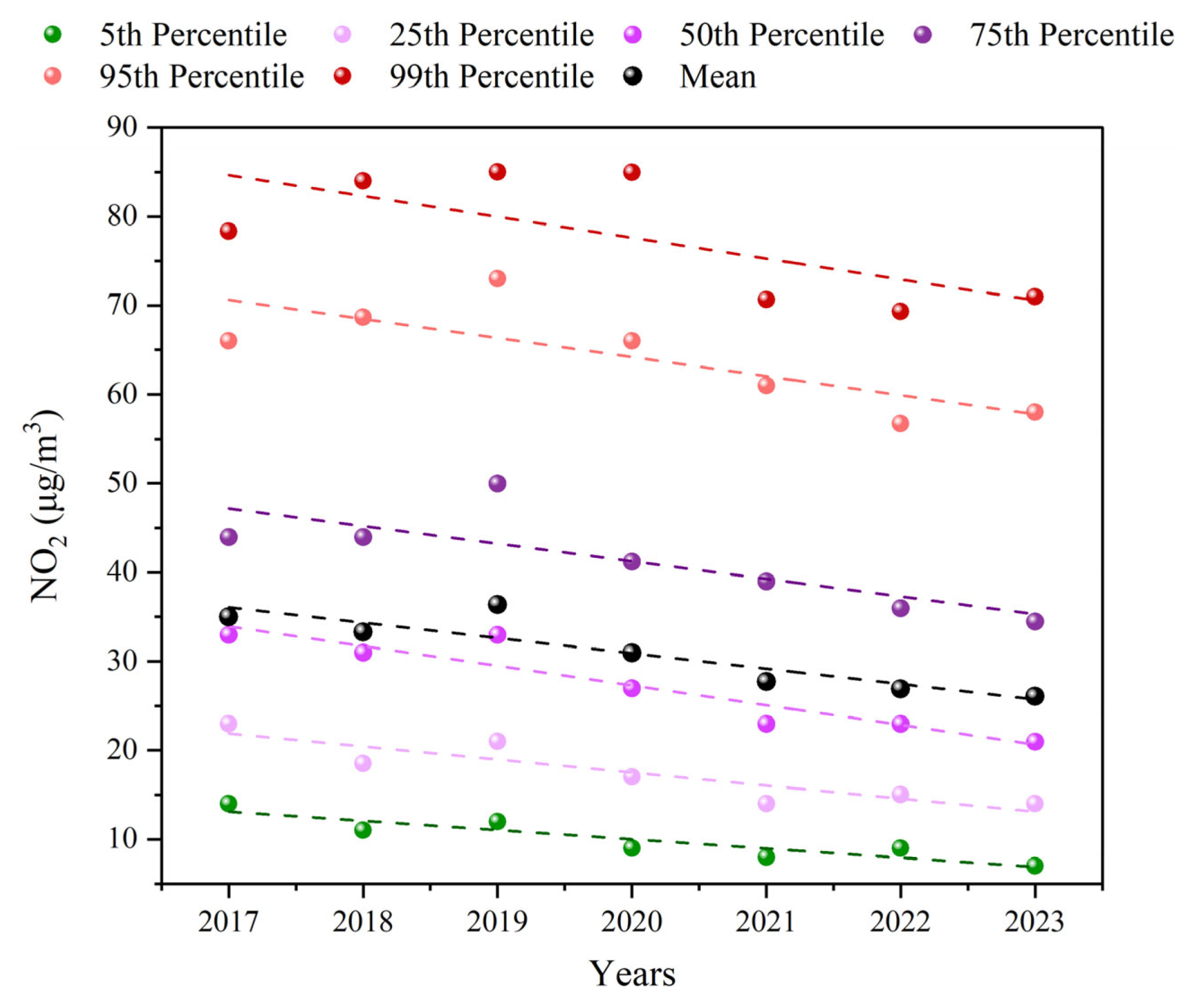
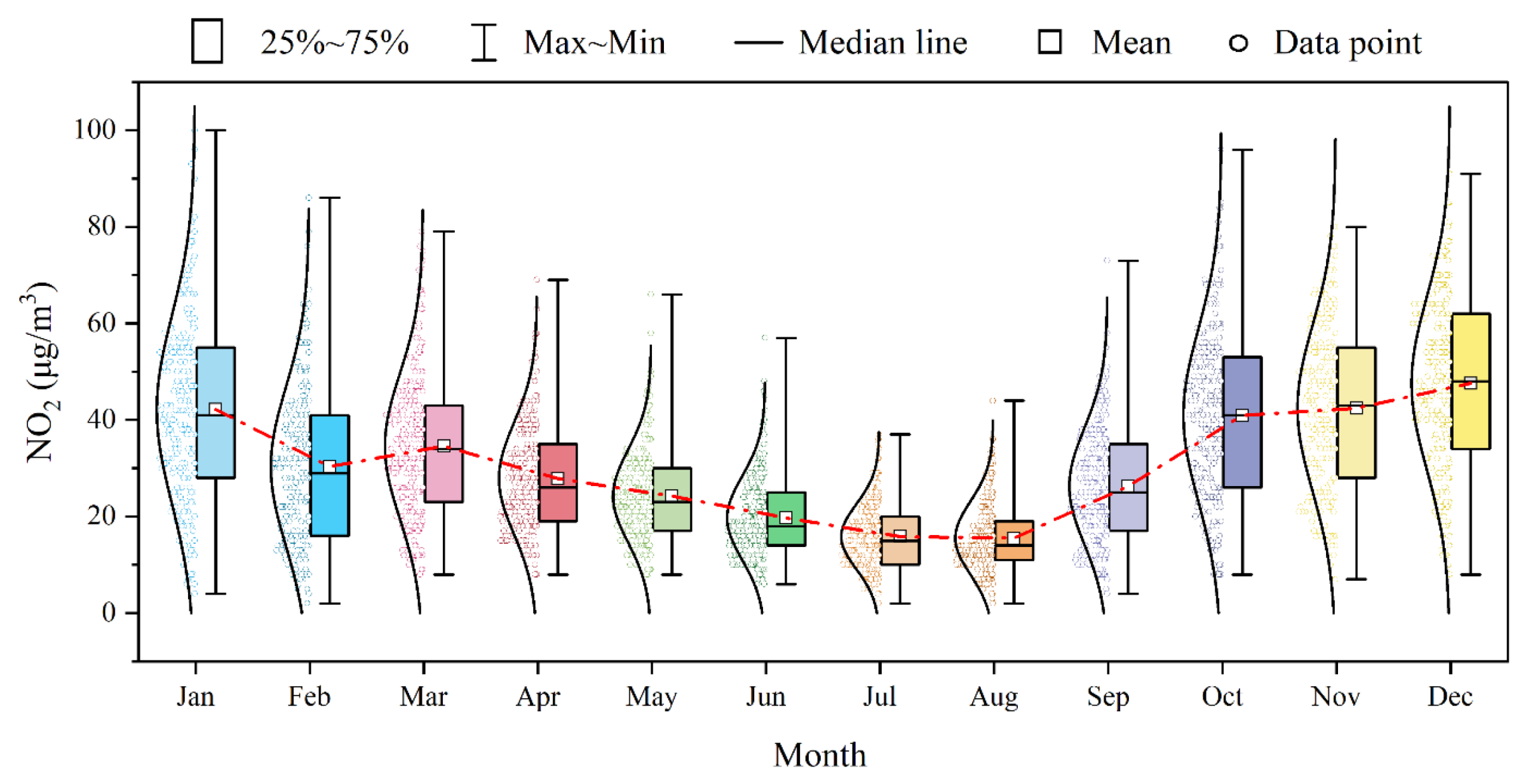
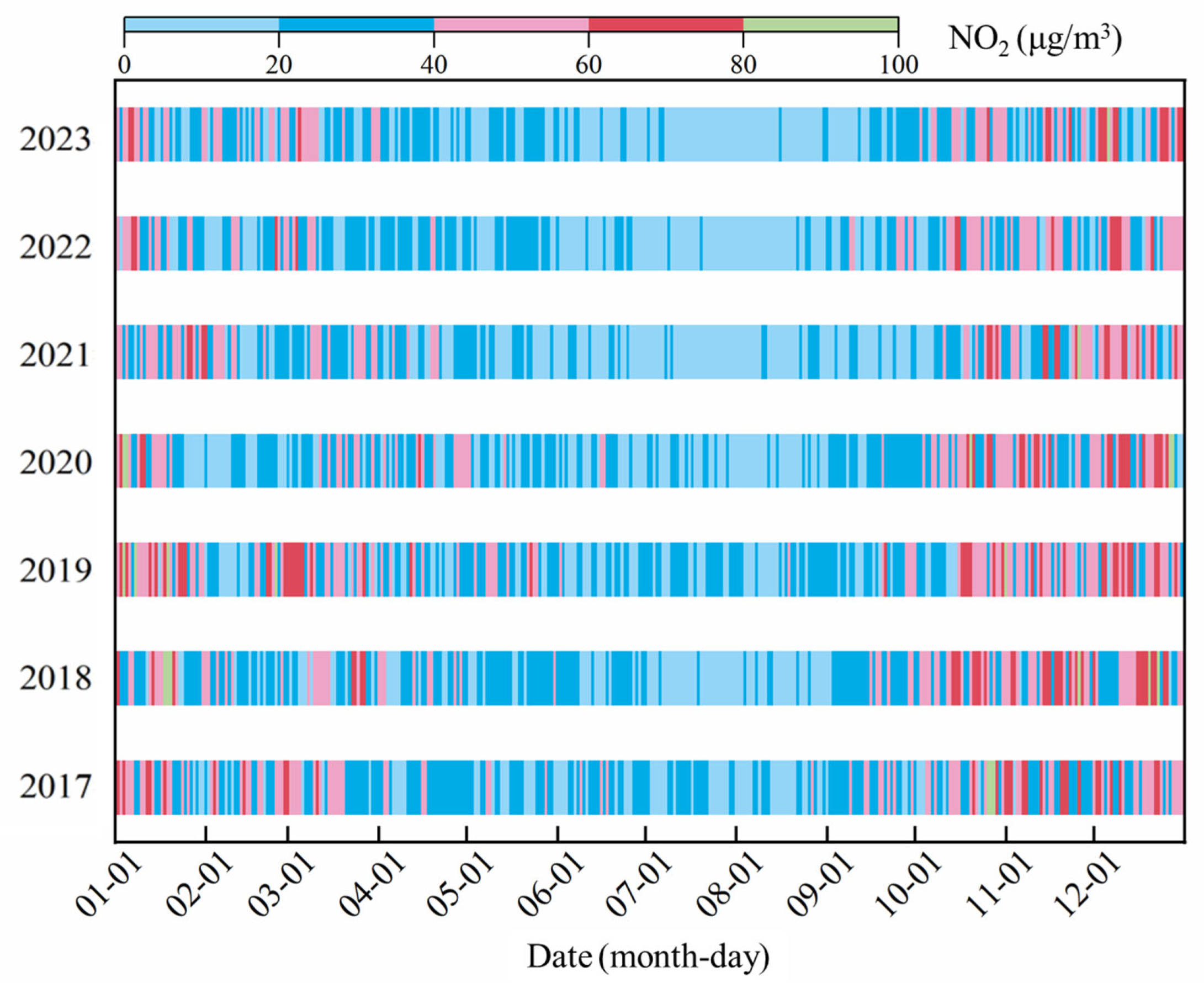

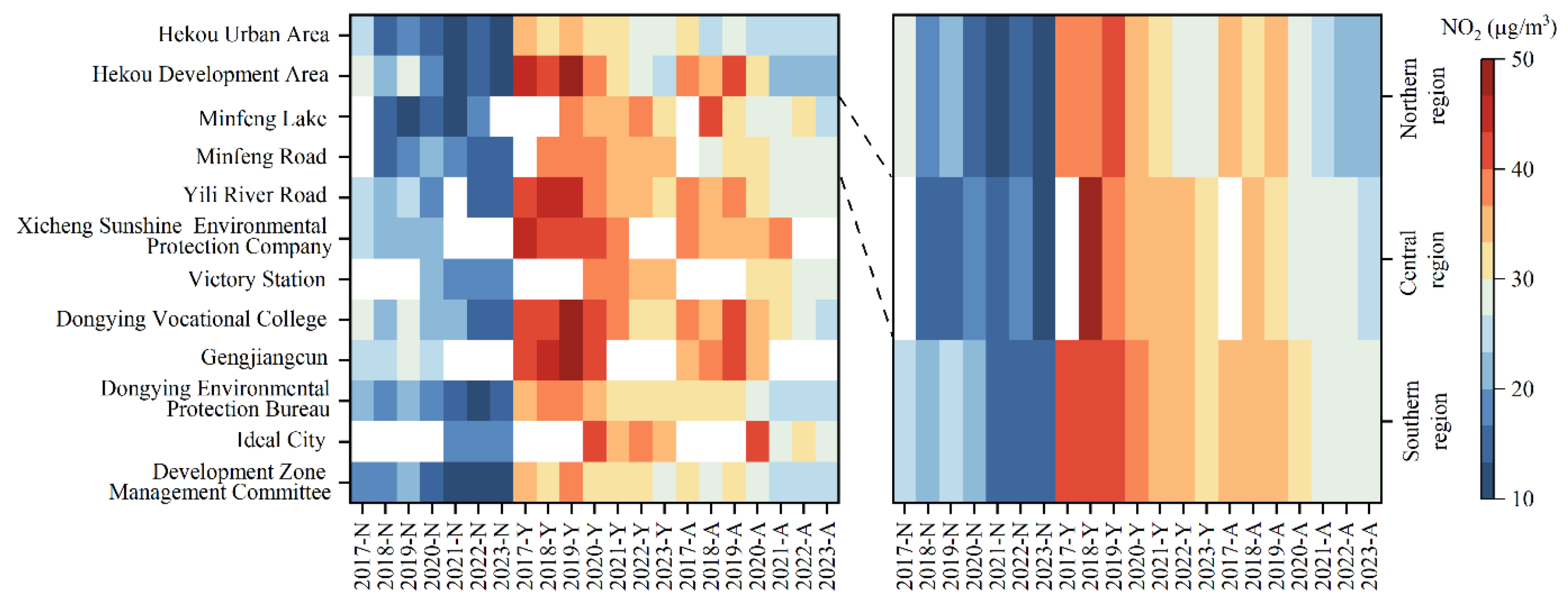



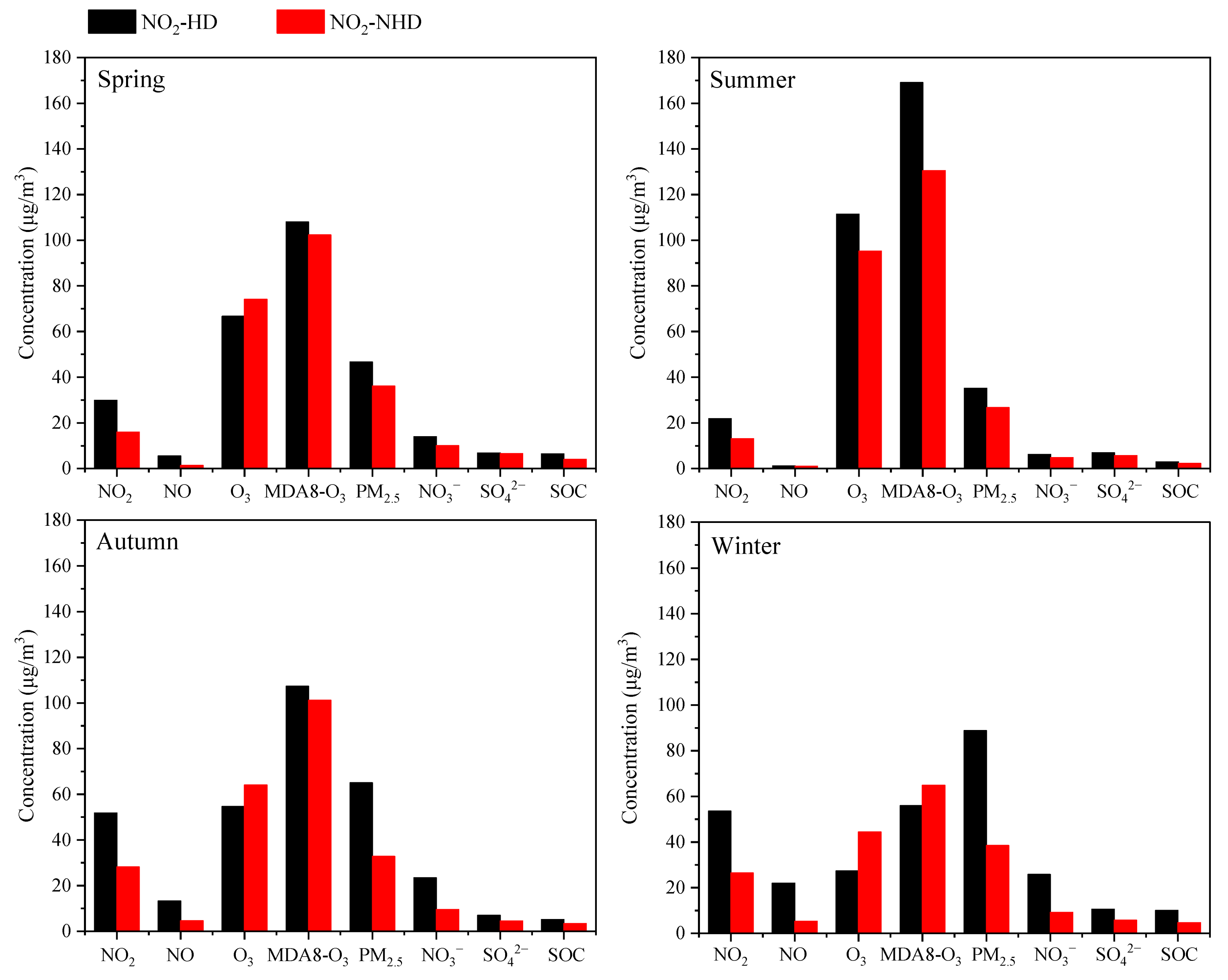
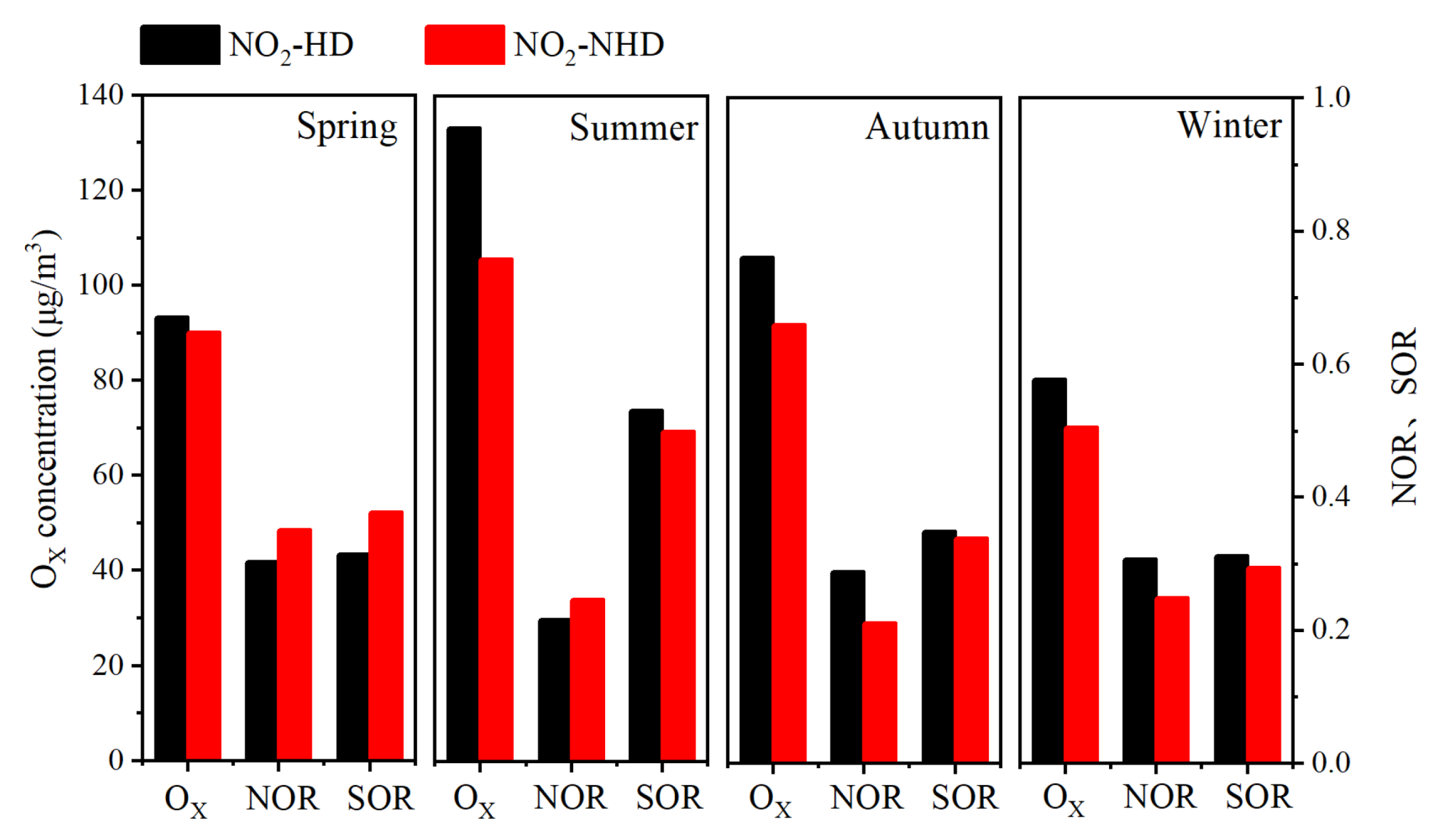
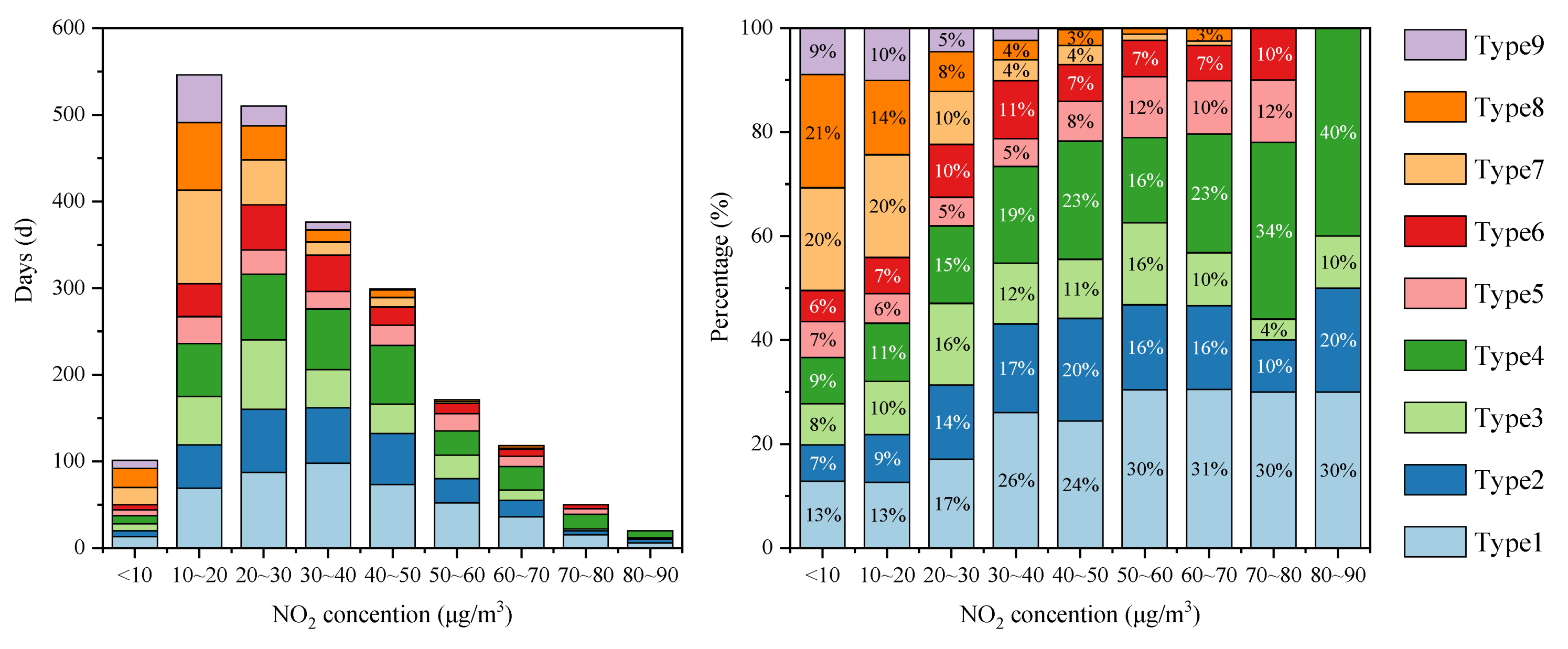


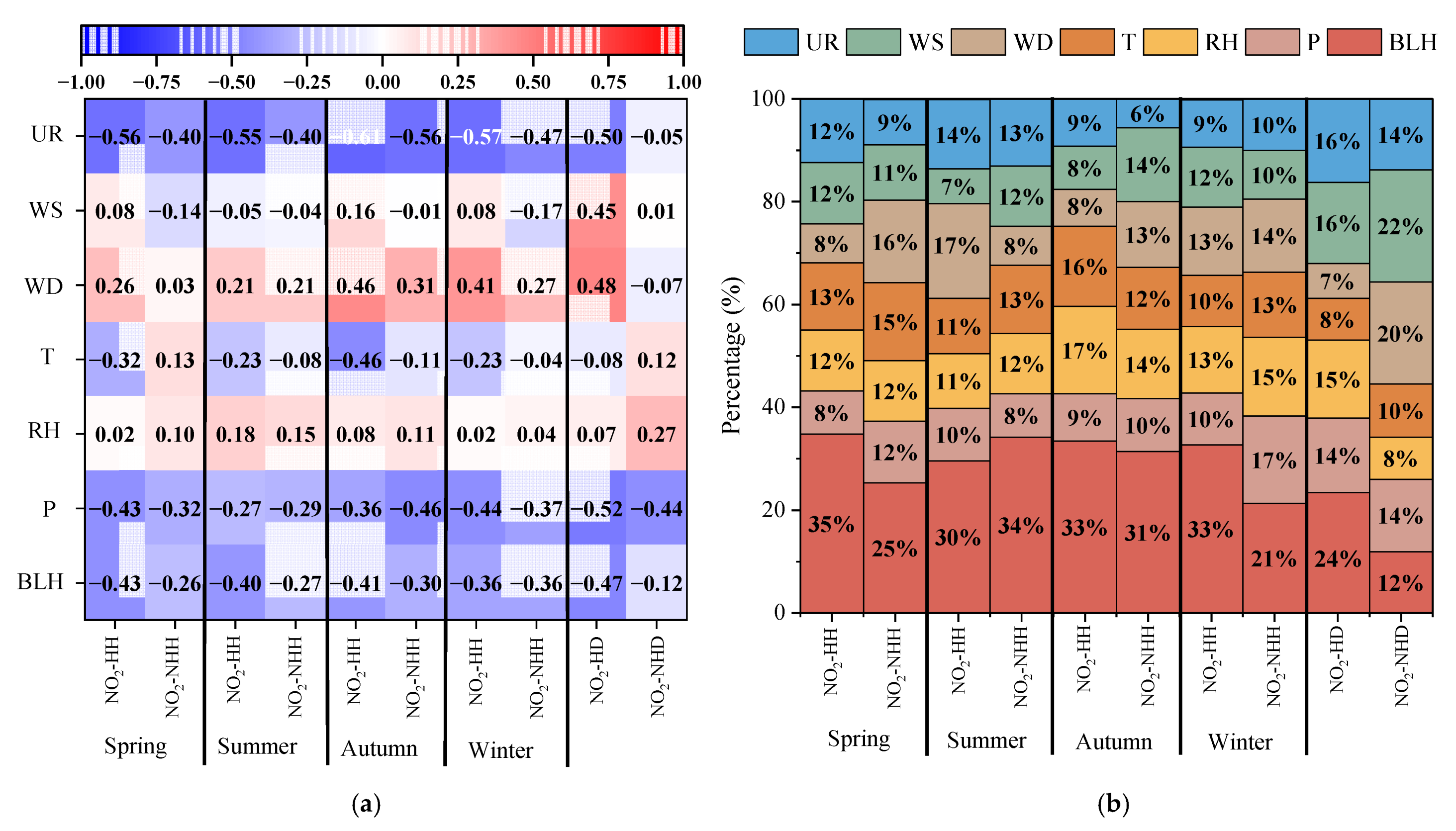
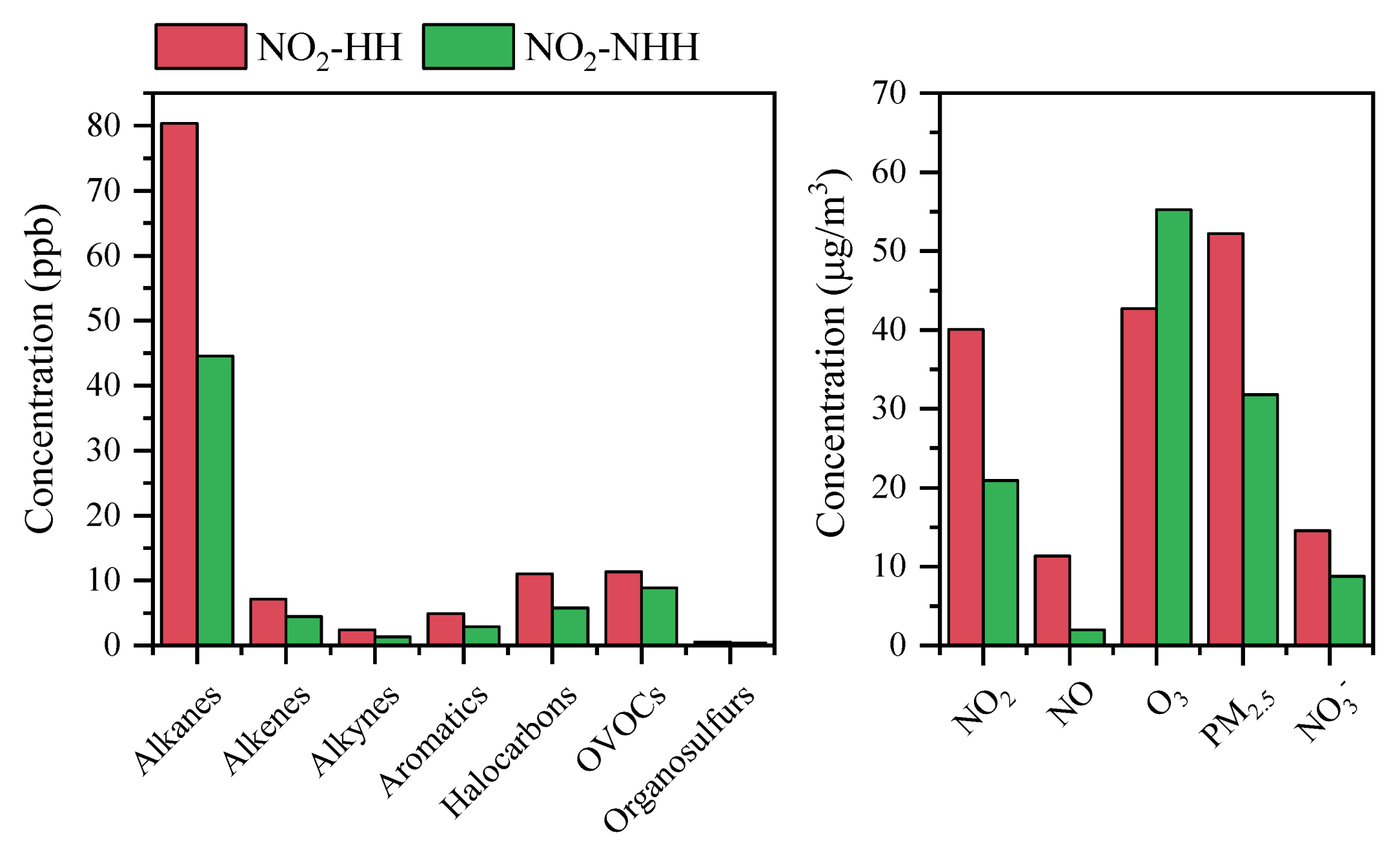
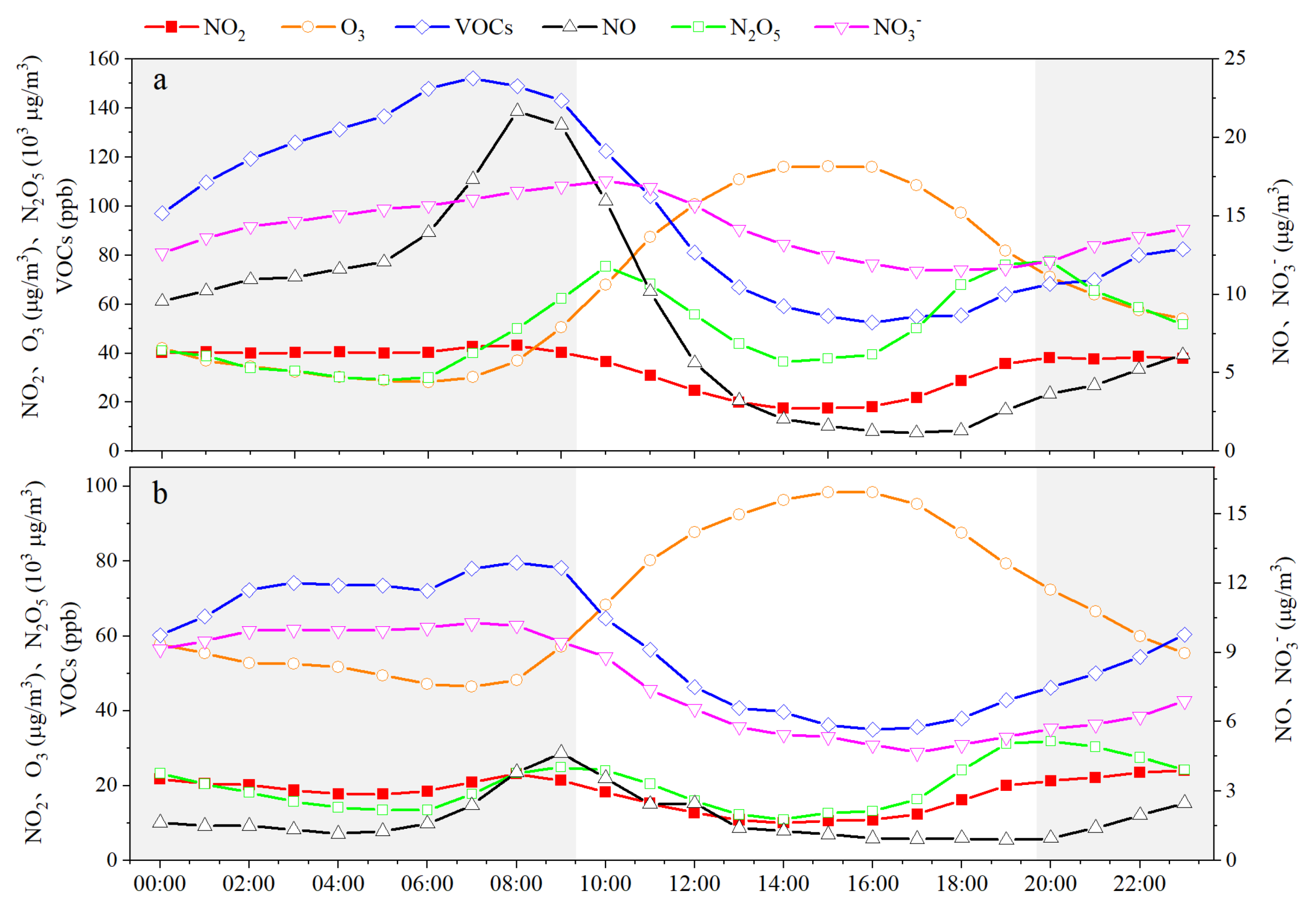

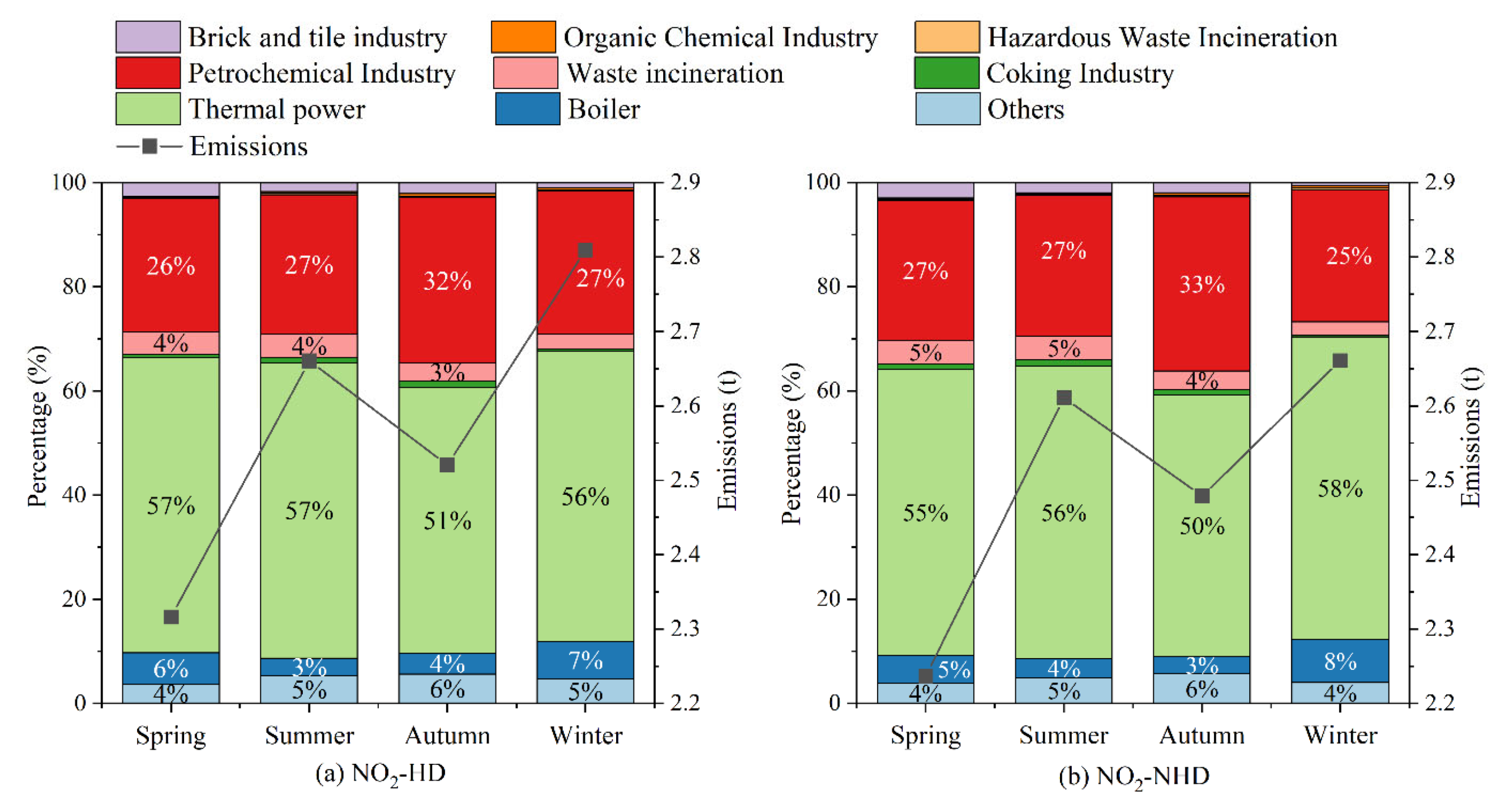

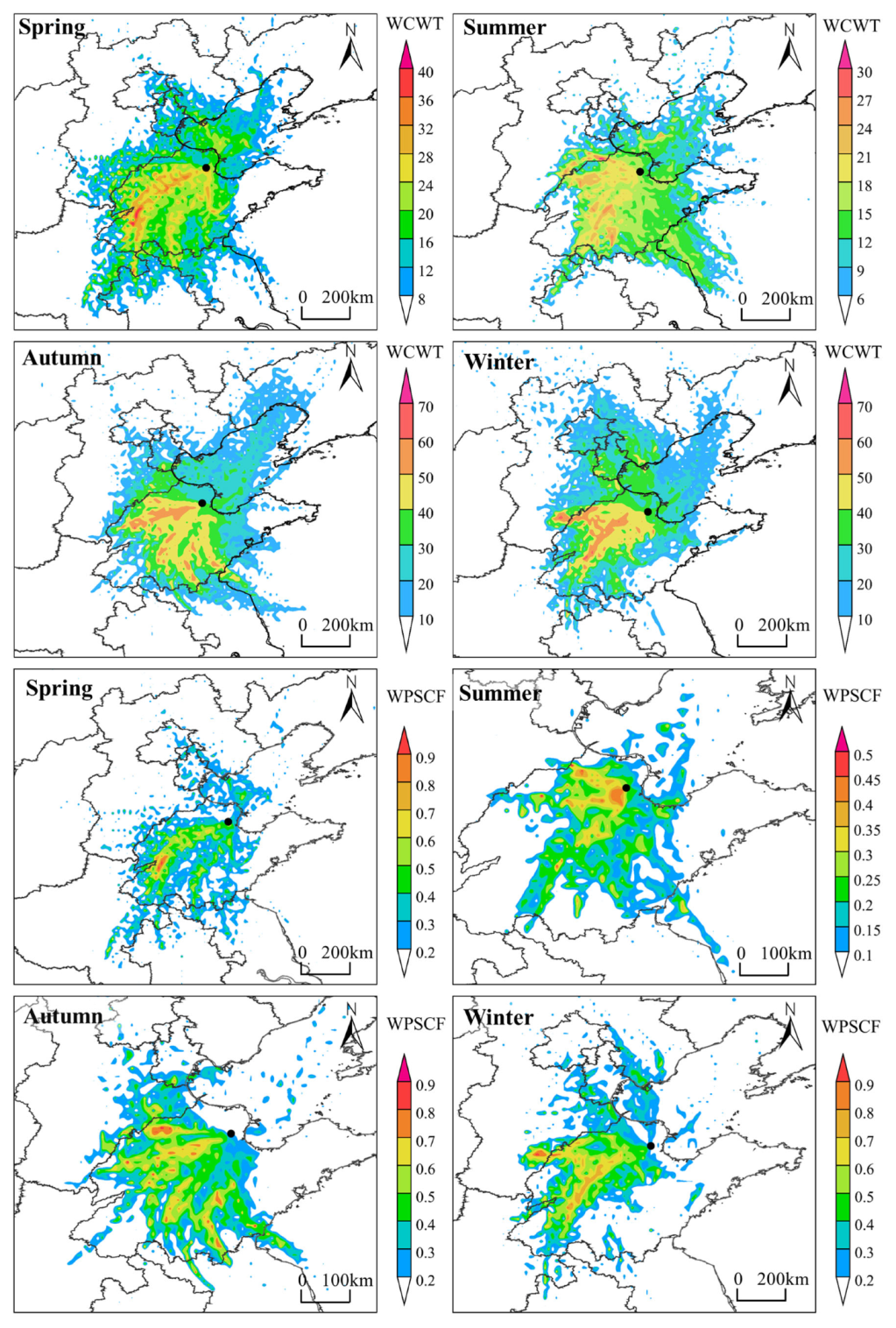
| Synoptic Pattern | Frequency | Major Characteristics |
|---|---|---|
| Type1 | 20.5% | Dongying near the offshore high-pressure rear, with dominant southeasterly wind, Tmax-mean of 21.8 °C, RH-mean of 56.6%, and Pre-mean of 1.4 mm. |
| Type2 | 14.1% | High-pressure center over the Mongolian Plateau. Dongying under the front of the high-pressure, with dominant southeasterly wind, Tmax-mean of 10.4 °C, RH-mean of 53.9%, and Pre-mean of 0.8 mm. |
| Type3 | 12.1% | High-pressure center over the North China Plain. Dongying inside the high-pressure, with dominant easterly wind, Tmax-mean of 16.9 °C, RH-mean of 64.0%, and Pre-mean of 1.4 mm. |
| Type4 | 16.6% | High-pressure center over the North China Plain. Dongying under the top-front of the high-pressure, with dominant southwesterly wind, Tmax-mean of 14.5 °C, RH-mean of 57.0%, and Pre-mean of 0.9 mm. |
| Type5 | 6.7% | Dongying under the control of a weak pressure field with sparse isobars and stable synoptic condition, with dominant southerly wind, Tmax-mean of 17.3 °C, RH-mean of 64.0%, and Pre-mean of 1.9 mm. |
| Type6 | 8.4% | Dongying between a high- and low-pressure systems with dense isobars, with dominant southeasterly and southwesterly winds, Tmax-mean of 19.2 °C, RH-mean of 56.8%, and Pre-mean of 0.6 mm. |
| Type7 | 9.5% | Dongying in the northwest of the western Pacific subtropical high, with dominant southeasterly wind, Tmax-mean of 29.2 °C, RH-mean of 72.4%, and Pre-mean of 8.0 mm. |
| Type8 | 7.6% | Dongying near the inverted trough, with dominant southeasterly wind, Tmax-mean of 25.8 °C, RH-mean of 73.2%, and Pre-mean of 6.6 mm. |
| Type9 | 4.4% | Dongying inside the low-pressure field, with dominant southeasterly wind, Tmax-mean of 29.3 °C, RH-mean of 69.1%, and Pre-mean of 2.1 mm. |
Disclaimer/Publisher’s Note: The statements, opinions and data contained in all publications are solely those of the individual author(s) and contributor(s) and not of MDPI and/or the editor(s). MDPI and/or the editor(s) disclaim responsibility for any injury to people or property resulting from any ideas, methods, instructions or products referred to in the content. |
© 2025 by the authors. Licensee MDPI, Basel, Switzerland. This article is an open access article distributed under the terms and conditions of the Creative Commons Attribution (CC BY) license (https://creativecommons.org/licenses/by/4.0/).
Share and Cite
Gao, X.; An, C.; Yan, Y.; Ji, Y.; Wei, W.; Xue, L.; Gao, R.; Shang, F.; Li, J.; Tan, L.; et al. Impacts of NO2 on Urban Air Quality and Causes of Its High Ambient Levels: Insights from a Relatively Long-Term Data Analysis in a Typical Petrochemical City in the Bohai Bay Region, China. Toxics 2025, 13, 208. https://doi.org/10.3390/toxics13030208
Gao X, An C, Yan Y, Ji Y, Wei W, Xue L, Gao R, Shang F, Li J, Tan L, et al. Impacts of NO2 on Urban Air Quality and Causes of Its High Ambient Levels: Insights from a Relatively Long-Term Data Analysis in a Typical Petrochemical City in the Bohai Bay Region, China. Toxics. 2025; 13(3):208. https://doi.org/10.3390/toxics13030208
Chicago/Turabian StyleGao, Xiaoshuai, Cong An, Yongxin Yan, Yuanyuan Ji, Wei Wei, Likun Xue, Rui Gao, Fanyi Shang, Jidong Li, Luyao Tan, and et al. 2025. "Impacts of NO2 on Urban Air Quality and Causes of Its High Ambient Levels: Insights from a Relatively Long-Term Data Analysis in a Typical Petrochemical City in the Bohai Bay Region, China" Toxics 13, no. 3: 208. https://doi.org/10.3390/toxics13030208
APA StyleGao, X., An, C., Yan, Y., Ji, Y., Wei, W., Xue, L., Gao, R., Shang, F., Li, J., Tan, L., & Li, H. (2025). Impacts of NO2 on Urban Air Quality and Causes of Its High Ambient Levels: Insights from a Relatively Long-Term Data Analysis in a Typical Petrochemical City in the Bohai Bay Region, China. Toxics, 13(3), 208. https://doi.org/10.3390/toxics13030208







